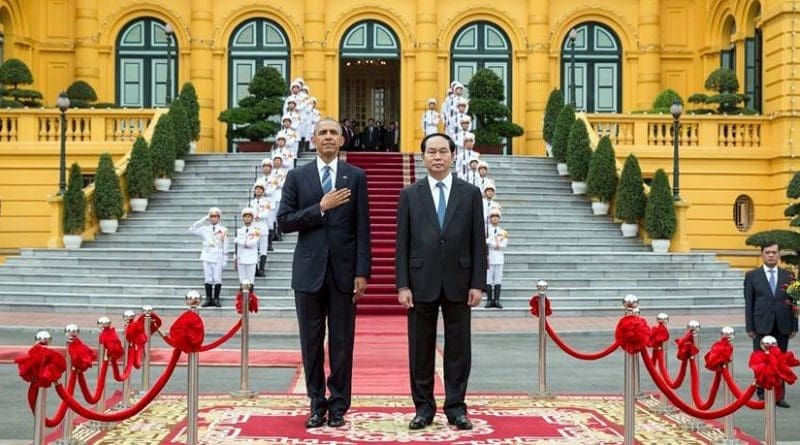A Decade Of US ‘Pivot To Asia’ – Analysis
By Manohar Parrikar Institute for Defence Studies and Analyses (MP-IDSA)
By Anushka Saxena*
The ‘Pivot to Asia’, the strategic rebalance announced by President Barack Obama in 2011 and early 2012, marked a significant shift in US foreign policy priorities from the Middle East to the Asia-Pacific. While speaking at the Australian Parliament in November 2011, Obama stated that as a Pacific nation, “the United States will play a larger and long-term role in shaping this region and its future, by upholding core principles and in close partnership with our allies and friends.”1 The ‘Pivot’ comprised an enhancement of America’s military and security engagement as well as the expansion of its economic and commercial leverage in the ‘Asia-Pacific’ region,2 at a time when it was mired in ‘forever wars’ in the Middle East.3
The pivot was announced at a time when China was becoming more aggressive in its neighbourhood. Its territorial claims spanned the Spratly and Paracel islands in the South China Sea, as well as islands in Japanese territorial waters. China also made economic inroads in Southeast Asia through trade-linked incentives. China’s rise severely threatened the regional order and the interests of the US and its allies like Japan and Australia.4
The Pivot was a welcome policy change for US allies in the Asia-Pacific, with analysts noting that the US giving priority to Asia was “long overdue”.5 When the then Secretary of State Hillary Clinton visited the ASEAN Secretariat in 2009, ASEAN Secretary-General Surin Pitsuwan stated that her visit showed “the seriousness of the United States to end its diplomatic absenteeism in the region”. Domestic politics, an important driver of American foreign policy, also turned against the US’s continued engagement in the Middle East. As per a 2011 Pew Survey, 57 per cent of the respondents opposed the war in Iraq, while 52 per cent opposed the Afghan war.6
As part of the pivot, the assurances the US made especially to Australia were widely welcomed. The US announced additional troop deployments to Australia, from 250 to 2,500 marines at the Darwin base.7 The US made similar military commitments to Singapore and the Philippines as well, while promising to make US military presence in East Asia “more broadly distributed, more flexible, and more politically sustainable”.8
The US also engaged in negotiations on the Trans-Pacific Partnership (TPP) with 11 Pacific Rim economies—Australia, Brunei, Canada, Chile, Japan, Malaysia, Mexico, New Zealand, Peru, Singapore, and Vietnam. Obama’s interest in joining this trade deal, as he famously articulated in 2015, was that “if we don’t write the rules, China will write the rules out in that region”, indicating clearly the containment tenet of the TPP.9 This was at a time when the trade deficit with China was US$ 282 billion in 2011.10 The TPP assured member states of America’s renewed commitment to the economic integration of the region.11
For US partners in the Indo-Pacific, namely the Philippines, Japan and Australia, the anti-China bend of the pivot was assuring, given that they were engaged in maritime disputes with China. To show the US’ commitment to the pivot, Obama invited Japan, Australia and Vietnam, for the first time, to participate in the joint bilateral US–Philippines naval exercise, Balikatan in 2012.12
However, not all ASEAN countries, especially Indonesia, were comfortable with the idea of the US increasing its troop presence in the Darwin and Guam bases. The Philippines was criticised for opening the region to a higher possibility of great power contestation between the US and China. 13
The US withdrew from the TPP right after Obama’s presidency, even as China’s regional integration initiatives such as the Belt and Road and the Regional Comprehensive Economic Partnership (RCEP) gathered steam. While the Trump administration’s anti-China focus remained intact, the US increasingly dissociated from its commitments to the region. Trump, for instance, withdrew from the Trans-Pacific Partnership, a cornerstone of Obama’s Pivot, in January 2017. Marking a break from Obama’s emphasis on regional multilateralism, Trump did not attend the ASEAN Summits in 2018, 2019 and 2020, while also declining to be a part of the East Asia Summits of 2017, 2018, 2019 and 2020.14 The Trump administration remained engaged with Middle East contentions, curating the Abraham Accords and also withdrawing from the Joint Comprehensive Plan of Action (JCPOA).
The security tenet of the Pivot also faced issues on the US–Japan front, due to debates regarding the relocation of US marines from the Futenma base in Okinawa prefecture, to a new base in Henoko Bay in the same prefecture.15 While the Japanese federal government made provisions for the relocation, the local government and the people of Henoko Bay were against it. The recent re-election of Denny Tamaki as Governor of Okinawa, who campaigned on preventing the development of a new base in Henoko, indicates that such sentiments are still strong.16
After the Pivot, there was a noteworthy rise in active military and civilian personnel deployed by the US to Japan. The number of deployed personnel to Japan was 55,278 as of September 2011, and by December 2015, it grew to 78,092. However, under Trump, the number fell to 46,334 as of December 2016. The number of troops stood at 62,722, as of June 2022.17
Even though the Trump administration dis-engaged multilaterally from the region, the ‘Indo-Pacific’ became a construct of significance in US foreign policy during his presidency, as evident from the renaming of the US Pacific Command (USPACOM) as the US Indo-Pacific Command (USINDOPACOM) in 2018. Additionally, the Trump administration announced the Asia Reassurance Initiative Act (ARIA) in 2018, which outlined a detailed financial breakup for promoting US security and economic interests in the Indo-Pacific Region.18
Under President Joe Biden, meanwhile, a renewed multilateral economic emphasis towards the region as a whole came through the Indo-Pacific Economic Framework (IPEF). The IPEF’s agenda include trade, supply chain resilience, economic resilience and clean energy and decarbonisation. To strengthen regional security engagements, the Biden administration tabled the Pacific Deterrence Initiative (PDI) in May 2021 and the US along with the other Quad member countries announced the Indo-Pacific Partnership for Maritime Domain Awareness. The AUKUS agreement between the US, UK and Australia, which involves the transfer of US nuclear naval propulsion technology to Australia, is a further significant move reinforcing the capabilities of a key regional ally to counter security threats. In the latest US National Security Strategy, released on 12 October 2022, the Biden administration argues that “no region will be of more significance to the world and to everyday Americans than the Indo-Pacific”.19
A decade after the pivot, therefore, with an ascendant China looming large in the regional geo-strategic framework, US strategic priorities towards the Indo-Pacific have been well and truly reinforced and strengthened.
Views expressed are of the author and do not necessarily reflect the views of the Manohar Parrrikar IDSA or of the Government of India.
*About the author: Ms Anushka Saxena is pursuing her Masters degree in International Relations from the O.P Jindal Global University, India, and is concurrently working as a Research Intern with the Institute of Chinese Studies, New Delhi.
Source: This article was published by Manohar Parrrikar IDSA
- 1.“Remarks by President Obama to the Australian Parliament”, The White House Office of the Press Secretary, 17 November 2011.
- 2.The origin of the term ‘Indo-Pacific’, in contemporary geopolitics, is attributed to Shinzo Abe’s 2007 speech to the Indian Parliament titled ‘Confluence of the Two Seas’. The term ‘Indo-Pacific’ was used in the US National Security Strategy of December 2017. Subsequently, the US Pacific Command (USPACOM) was renamed as the US Indo-Pacific Command (USINDOPACOM), and the ‘Indo-Pacific Strategy Report’ was published by the Department of Defense in 2019. Prior to this, the term ‘Indo-Asia-Pacific’ was used in 2014 by US officials.
- 3.Lucian Staiano-Daniels, “America Doesn’t Control the Forever Wars”, Foreign Policy, 15 January 2022.
- 4.Zhao Lei, “PLA Advances in Arms, Ability Over Past Decade”, China Daily, 16 August 2022.
- 5.“What Asia Wants from the US: Voices from the Region”, Asan Institute for Policy Studies, 2018.
- 6.“Chapter 5: The Public and the Military”, Pew Research Center, 5 October 2011.
- 7.David Nakamura, “Obama: U.S. to Send 250 Marines to Australia in 2012”, Washington Post, 16 November 2011.
- 8.Rong Chen, “A Critical Analysis of the U.S. ‘Pivot’ toward the Asia-Pacific: How Realistic is Neorealism?”, Connections, Volume 12, Issue 3, Partnership for Peace Consortium of Defense Academies and Security Studies Institutes, 2013.
- 9.“Obama: If We Don’t Write Trade Rules, China Will”, Wall Street Journal, 28 April 2015.
- 10.David Shambaugh, “Assessing the US ‘Pivot’ to Asia”, Strategic Studies Quarterly, Volume 7, Issue 2, Air University Press, 2013.
- 11.“Remarks by President Obama to the Australian Parliament”, The White House Office of the Press Secretary, 17 November 2011.
- 12.Yuki Tatsumi, “US-Japan-Australia Security Cooperation: Prospects and Challenges”, Stimson Center, 2015.
- 13.“What Asia Wants from the US: Voices from the Region”, Asan Institute for Policy Studies, 2018.
- 14.Nick Aspenwall, “Duterte Terminates U.S. Defense Pact, Pleasing Trump but Few Others”, Foreign Policy, 14 February 2020; Josh Rogin, “Trump’s Latest Summit No-shows Are His Final Insult to America’s Asian Allies”, The Washington Post, 17 November 2020.
- 15.Mark E. Manyin et al., “Pivot to the Pacific? The Obama Administration’s ‘Rebalancing’ Toward Asia”, Congressional Research Service, 28 March 2012.
- 16.“Anti-U.S. Base Incumbent Gov. Denny Tamaki Wins Okinawa Vote”, Japan Times, 11 September 2022.
- 17.“DoD Personnel, Workforce Reports & Publications”, Defense Manpower Data Center, US Department of Defense.
- 18.“The Asia Reassurance Initiative Act (ARIA) of 2018”, Congressional Research Service, 4 April 2019.
- 19.“National Security Strategy”, The White House, Washington, 12 October 2022, p. 38.

